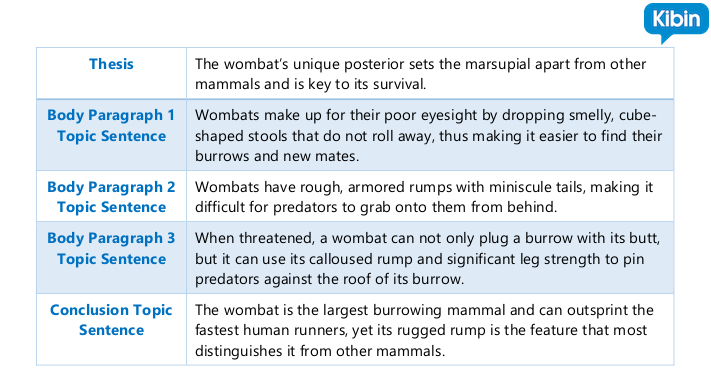“Man, this essay is going to be impossible.” We’ve all been in this boat before, confronted with an essay assignment that is beyond difficult.
What if I told you that I can teach you how to write an essay about pretty much anything under the sun?
Even … hmm …wombats.
“What? Why wombats?” you wonder. Well, for one, just look how flipping CUTE the little guy is.
But also, I want to make a point about this random noun I literally plucked out of thin air: no essay topic is actually impossible, as you will see.
In this post, I’m going to teach you how to write an essay on just about anything under the sun, from brainstorming through proofreading.
First, we’ll review the essential elements of a good essay, and then I’ll detail a foolproof process that will lead you to a unique, interesting essay on just about anything you — or your teacher — can imagine.
What Are the 3 Essential Elements of a Great Essay?
There are three essential elements every essay needs to be, well, an essay. These include:
- a thesis,
- broad appeal, and
- structure.
Let’s break these elements down a little bit.
1. Thesis Statement
The most essential ingredient of a great essay is a clear central idea. This is usually called a thesis statement.
The thesis statement makes your purpose for writing clear. Your readers will know whether they should prepare to be entertained, informed, or so moved they’ll need to bring Kleenex.

The thesis also lays out your claims or opinions about your topic. It means taking a stand for what you believe to be true about your topic or what you will prove through your writing.
2. Broad Appeal
The second element of a great essay is broad appeal. By that, I mean that your essay needs to have meaning to your audience — not just yourself. An informative essay, for instance, should teach your audience something they might feasibly want to know.
This applies to personal essays, too. Even though the essay is about you, it should serve a larger purpose or highlight some truth about the world or how things work. If you are literally the only person on earth who cares about your topic, you could certainly still write an essay about it.
But what’s the point?
Ultimately, a great essay has to pass the “So what?” test.
No one should read your thesis — let alone reach the end of your conclusion — and be able to reasonably ask, “So what?”
3. Structure
Lastly, every essay needs a structure. It could have as few as three paragraphs — introduction, body, conclusion — or go on for pages and pages and pages. Either way, there should be a logical framework that guides the reader through your writing.
No matter what you’re writing about, these three elements will put you on the road to a great essay.
Now, let’s look at a process that walks you through how to write an essay — about anything!
How to Write an Essay that Rocks — Every Time
No matter what type of essay you’re writing or how long it will be, there is a set of reproducible steps you can take to prepare for writing, to write your paper, and to revise your writing. Best of all, you can adapt these steps to fit essay assignments ranging from 1 page to 100.
Step 1: Research your topic
Research can mean many things. In an literary analysis essay, your research might entail a close reading of a specific text or reading literary journals to determine what other critics have said about your topic.
And if you’re feeling a bit smug because you’re writing a personal essay and think you get to skip this step, think again. Research can also mean talking to others who share your memories of an event, digging through old photos for inspiration, and so forth.
If having an item, a fact, a figure, a quote, or a recollection will help you write a stronger, richer essay, then now is the time to go look for it.
Keep your eyes open for what Joe Bunting of The Write Practice calls “the story of surprise.” Jot down things that are surprising, shocking, or interesting about your topic during the research phase — these often lead to the best essays.
Take that sweet, cuddly wombat I mentioned earlier, for instance. In doing a little research, I found out that wombats poop cubes and use their armored butts as weapons. Color me surprised!
Step 2: Mull it over
Professor Cal Newton recommends that you take an “idea vacation” — hey, it’s not Hawaii, but it is free. He says that after you’ve done some research, but before you’ve pinned down your main idea, you should walk away from the computer. Just go be with your ideas.

I’m inclined to agree with him. Some of my best ideas have struck when I was washing the dishes, taking a walk, driving, or otherwise not at the keyboard. (I’m not sure that pondering wombat poop ranks among my best ideas).
Nonetheless, I absolutely recommend that you leave yourself enough time to take such a brainstorming break when your research is done.
I also want you to ignore your first few ideas. No, I mean it — throw them out. Poof! They’re gone.
Before you get mad at me for wasting your time, though, let me explain: don’t go with the low-hanging fruit. Your first few ideas about your topic are probably obvious and easy.
Think about it this way: if they’re the first things you thought of when considering your topic, they’re probably the things your audience would have thought of, too. Bo-ring.
When you feel as though you have some solid ideas for what you want to say about your topic, move on to the next step.
Step 3: Narrow your focus and write your thesis

Vacation over!
Now that you’ve had a bit of respite, you probably have a pretty good overview of your topic and some interesting ideas about how you will approach it. But now is the point when you want to narrow your focus and hone in on a thesis statement.
You don’t want your topic to be so broad that you can barely touch on one subtopic before moving on to the next. At the same time, you don’t want a topic so specific that you can barely find anything to say about it, either.
So how do you find the middle ground?
Let’s revisit our wombat friends to see this idea in action. An informative essay describing why wombats are all-around bad*sses? Yup, totally doable. But what if you’re limited to two pages?
Covering every facet of this critter’s awesomeness in so few pages would hardly do it justice. Therefore, I decided to focus on just one element: its bum.
I know, I know. But we’re all adults here, right? (Haha, wombat butts!) Thanks to my research, I now know that wombats have rather robust rumps that protect and serve them in a variety of ways. I could also feasibly cover that topic in detail in a short essay.
Therefore, I wrote the following thesis:
The wombat’s unique posterior sets the marsupial apart from other mammals and is key to its survival.
Okay, you try! Check out How to Write a Thesis Statement in 5 Simple Steps and What Twitter Can Teach You About Writing a Thesis Statement for some additional thesis statement tips and tricks.
Step 4: Outline your essay
Now that you have a main idea, it’s best to organize your ideas into an outline. In fact, by the time you’re done with this step, you’ll have the five most important sentences of your essay written.
Don’t feel as though you have to reinvent the wheel when it comes to your essay’s structure. Read How to Write a 5-Paragraph Essay Outline, How to Create a Powerful Argumentative Essay Outline, or Use this Expository Essay Outline to Stop Procrastinating for tips on outlining several different types of essays.
For my hypothetical essay outline, I’m using the basic 5-paragraph structure featuring an introduction, three body paragraphs, and a conclusion. Your essay may have more or fewer paragraphs, but this is a great, basic structure to build upon.
You don’t have to write complete sentences to fill in an outline, but I recommend that you do. It’s just five sentences, after all: your thesis, a topic sentence for each paragraph, and a topic sentence for your conclusion that ties back to the thesis.
Check out my example below:
Step 5: Draft your essay
Phew, finally.
It probably seems like you’ve done a lot of work up to this point. (You have.) You might wonder whether all that was really necessary. (It was.)
But here’s the thing: by now, you know what you’re going to write about. You have sources to back up your claims. You know the structure your essay will take. And best of all, you already have the five most important sentences in your essay written.
All you have left to do is support the main ideas you’ve already written. You also need to lead into your thesis with a compelling hook.
And remember — just because your essay needs to have an introduction, body, and conclusion when you finish doesn’t mean you have to write them in that order.
Personally, I find it easiest to write the body first, then the introduction, and then the conclusion. This way, I can jump right into the meaty part of the essay without wasting a lot of time thinking about my hook, and I don’t have to try and introduce writing that doesn’t exist yet.
Lastly, to make the drafting process as painless as possible, just worry about getting words on the page at this point. Follow your outline, of course, but don’t worry too much about editing yourself or getting things ‘just so’ — the time will come for editing.
Step 6: Revise and proofread
If at all possible, wait a day, or at least a few hours, before moving on to this step. You’ll be more patient, less frustrated, and better able to spot issues in your writing.
Start the revision process by reading through your essay and looking for problems with flow, clarity, structure, and logic. It’s okay to fix grammar or punctuation errors at this point if you spot them, but don’t focus on surface-level issues until you’ve patched up the deeper problems first.
Once you’re feeling confident about your content, it’s time to proofread. Reading your essay out loud is one of the best ways to spot grammar and punctuation errors and issues with wording — give it a shot!
Running short on time or patience? Let us help with this step! A fresh set of eyes (from the pros, no less) can help you spot major issues with your organization or clarity, and we can ensure that your essay is in its best possible shape before you turn it in.
Final Thoughts on How to Write an Essay About Anything

The next time you’re assigned a groan-worthy essay topic, repeat after me: “At least it’s not wombat butts.”
Need more inspiration? Check out thousands of example essays written by students just like you.
And take heart — you not only know more about wombats’ rear-ends than you could ever want, but you also know exactly how to write an essay about pretty much anything your teacher can throw at you.
BRING IT.


